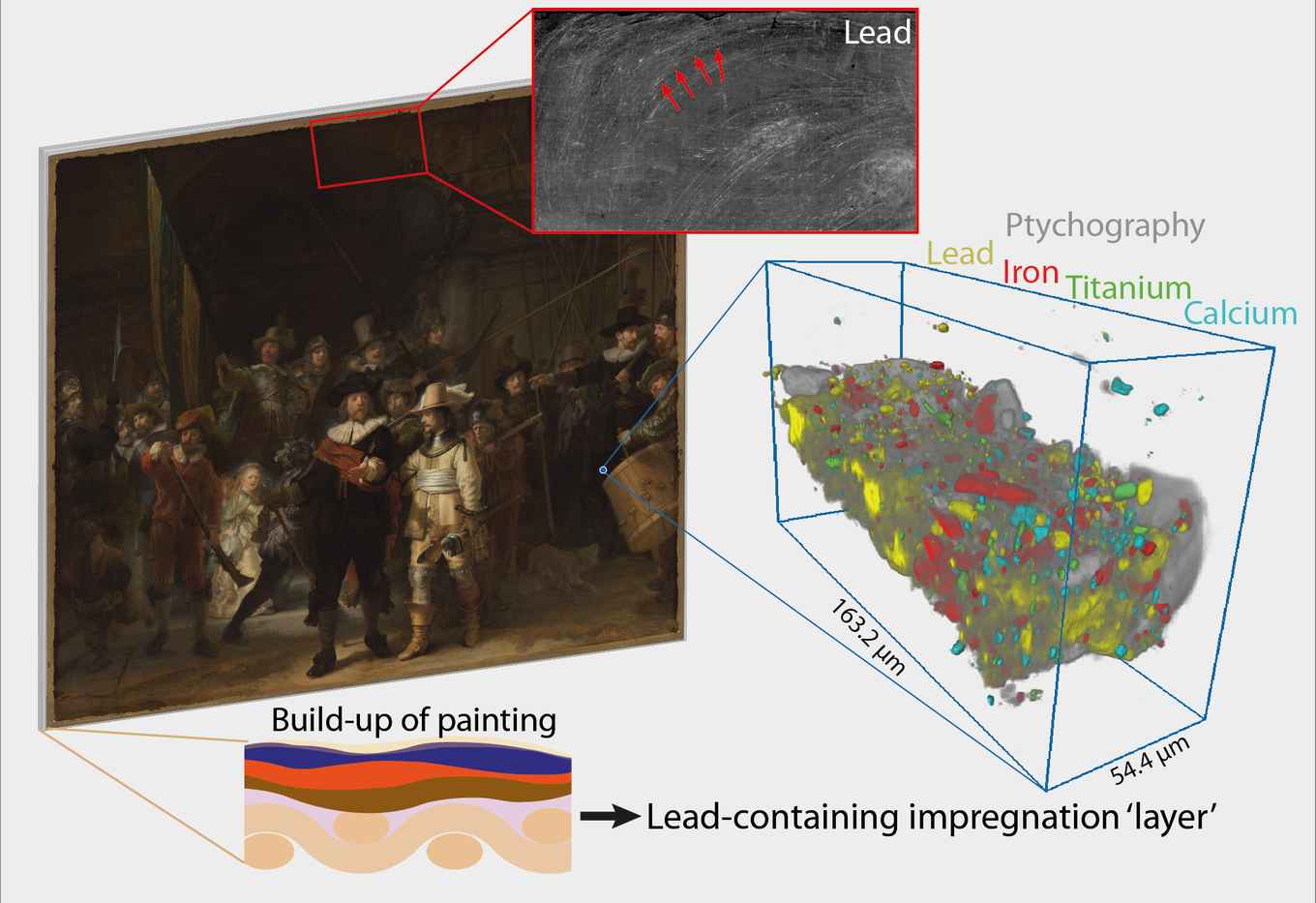Rembrandt broke new ground with lead-based impregnation of canvas for The Night Watch
15 December 2023

The surprising observation is yet another result from Operation Night Watch, the largest and most wide-ranging research and conservation project in the history of Rembrandt’s masterpiece. It resulted from advanced analysis of an actual paint sample taken from the historical painting. First author of the paper is Fréderique Broers, a researcher at the Rijksmuseum and PhD student with professors Katrien Keune (University of Amsterdam), Koen Janssens (University of Antwerp) and Florian Meirer (Utrecht University). Her research forms part of the research project 3D Understanding of Degradation Products in Paintings of the Netherlands Institute for Conservation+Art+Science+ (NICAS), funded by the Dutch Research Council NWO. Broers and coworkers employed a combination of x-ray fluorescence and ptychography to identify and visualize sub-microscale chemical compounds in the lower layers of the canvas. By sampling the small Night Watch paint fragment at DESY (Deutsches Elektronen-Synchrotron, Hamburg), they discovered the lead-rich layer below the quartz-clay ground layer of the canvas.
Protection against moisture
It was already known from earlier studies that Rembrandt had used a quartz-clay ground on the Night Watch. In earlier paintings he had used double grounds, consisting of a first ground containing red earth pigments followed by a second lead white containing ground. The large size of The Night Watch may have motivated Rembrandt to look for a cheaper, less heavy and more flexible alternative for the ground layer. Another issue he had to overcome was that the large canvas was intended for a damp outer wall of the great hall of the Kloveniersdoelen (musketeers’ shooting range) in Amsterdam. It had been reported that under humid conditions the common method of preparing the canvas using animal glue could fail. A contemporary source on painting techniques written by Théodore de Mayerne suggested impregnation with lead-rich oil as an alternative. This may have inspired Rembrandt for his unusual impregnation procedure to improve the durability of his masterpiece.
Computational imaging
The presence of this lead-containing ‘layer’ was discovered by the first-ever use of correlated x-ray fluorescence and ptychographic nano-tomography on a historical paint sample. This was performed at the PETRA III synchrotron radiation source at DESY. X-ray fluorescence is used to investigate the distribution of relatively heavy elements (calcium and heavier). Ptychography, a computational imaging technique based on experimentally obtained datasets, is capable of visualizing even the lightest elements and organic fractions.
Analysis of the micro sample taken from The Night Watch revealed that on the side of the sample closest to the canvas support a homogenous layer of dispersed lead was present in the ground layer. Since lead components were not to be expected in the quartz-clay ground layer, this was a rather puzzling observation. The results were then combined with the lead distribution map of the full Night Watch, obtained by X-ray fluorescence scanning of the painting in the Rijksmuseum’s Gallery of Honour. This map reveals the presence of lead throughout the painting and suggests application using large semi-circular brushstrokes, supporting the assumption that it results from an impregnation procedure. Even an imprint of the original strainer onto which the canvas was stretched when the preparatory layers were applied, is visible in the lead distribution map. This brings us yet another step closer to understanding Rembrandt’s creative process in painting The Night Watch, as well as its current condition.
Publication details
Fréderique T.H. Broers, Ige Verslype, Koen W. Bossers, Frederik Vanmeert, Victor Gonzalez, Jan Garrevoet, Annelies van Loon, Esther van Duijn, Anna Krekeler, Nouchka De Keyser, Ilse Steeman, Petria Noble, Koen Janssens, Florian Meirer, Katrien Keune: Correlated x-ray fluorescence and ptychographic nanotomography on Rembrandt’s The Night Watch reveals unknown lead “layer”. Science Advances, 15 December 2023. DOI: 10.1126/sciadv.adj9394
See also
- Operation Night Watch
- Research into Chemistry for Conservation and Art at the University of Amsterdam
- Van 't Hoff Institute for Molecular Sciences